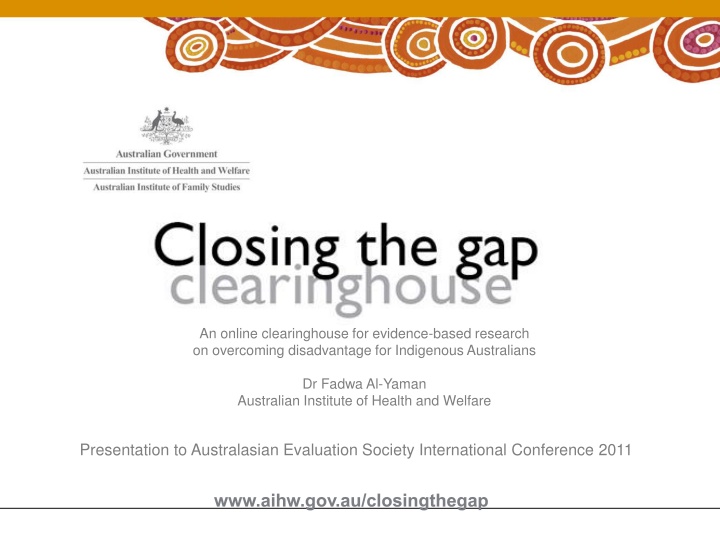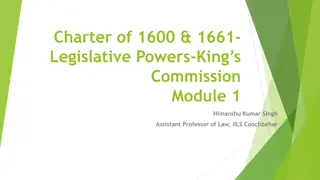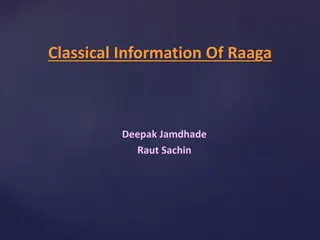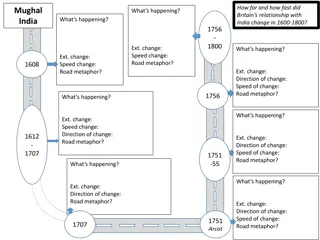Enhancing Indigenous Wellbeing: Evidence-Based Research Clearinghouse
An online clearinghouse, led by Dr. Fadwa Al-Yaman at the Australian Institute of Health and Welfare, aims to identify effective programs for Indigenous Australians. It focuses on key areas like life expectancy, education, and employment outcomes, providing resources and publications to inform policy decisions. The initiative covers Indigenous and non-Indigenous populations globally, offering assessments, levels of evidence, and annual reports to guide strategies for overcoming disadvantages.
Download Presentation

Please find below an Image/Link to download the presentation.
The content on the website is provided AS IS for your information and personal use only. It may not be sold, licensed, or shared on other websites without obtaining consent from the author.If you encounter any issues during the download, it is possible that the publisher has removed the file from their server.
You are allowed to download the files provided on this website for personal or commercial use, subject to the condition that they are used lawfully. All files are the property of their respective owners.
The content on the website is provided AS IS for your information and personal use only. It may not be sold, licensed, or shared on other websites without obtaining consent from the author.
E N D
Presentation Transcript
An online clearinghouse for evidence-based research on overcoming disadvantage for Indigenous Australians Dr Fadwa Al-Yaman Australian Institute of Health and Welfare Presentation to Australasian Evaluation Society International Conference 2011 www.aihw.gov.au/closingthegap
Outline Overview of the Clearinghouse Scope and process Available resources Limitations of current approach Future directions
Clearinghouse overview Purpose to identify programs/interventions that work to overcome Indigenous disadvantage (evidence-based evaluations) COAG initiative, jointly funded by all governments and delivered by the AIHW in collaboration with AIFS Primary audience is policy makers Governed by the Clearinghouse Board, with support from a Scientific Reference Group
Focus The Clearinghouse s efforts are directed across 7 building blocks which support the 6 COAG targets COAG Targets (6) Related to: 1. Life expectancy 2. Mortality rates for children 3. Early childhood education 4. Reading, writing and numeracy 5. Year 12 attainment 6. Employment outcomes Building Blocks (7) Health Early childhood Schooling Economic participation Healthy homes Safe communities Governance and leadership
Scope of the clearinghouse collections Indigenous Australians Non-Indigenous Australians Indigenous populations in USA, NZ and Canada Non- Indigenous populations in USA, NZ and Canada Other countries
Clearinghouse collections General collection Assessed collection- create an assessment tool General info Levels of evidence Adaptability of the evidence to Indigenous Australians Advice on rating of evidence Other relevant info Research & Evaluation Register
Clearinghouse publications Issues papers and resource sheets Final topics set by the Board following discussions with jurisdictions Key learnings and gaps in evidence An annual paper that summarises and synthesises the evidence and identifies the major gaps in the research Annual report An overview of the Clearinghouse s achievements.
Clearinghouse communications e-news - Quarterly newsletter about Clearinghouse activities Presentations and discussions of Clearinghouse resources in each jurisdiction Conference presentations Helpdesk
General collection 4,757 items Building Block Early childhood No. Per cent 1,413 30 Schooling 784 16 Health 1,764 37 Economic participation 929 20 Healthy homes 588 12 Safe communities 1,408 30 Governance and leadership 180 4 Total 4,757 100 Note: Items can be counted in one or more building blocks
Assessed items Building Block Early childhood No. Per cent 88 14 Schooling 140 23 Health 194 32 Economic participation 88 14 Healthy homes 53 9 Safe communities 92 15 Governance and leadership 52 9 Total 607 100
Characteristics of assessed collection by building block (%) evaluation component 100 80 Other Literature review 60 Evaluation component 40 20 0 Early child. Schooling Health Eco. Particip. Healthy homes Safe comm. Gov. & leader.
Characteristics of assessed collection by building block (%) cost component 100 No cost analysis 80 Cost-effective and cost-benefit 60 Cost-benefit 40 Cost-effective 20 0 Early child. Schooling Health Eco. Particip. Healthy homes Safe comm. Gov. & leader.
Characteristics of the assessed collection by building block and type of study (%) 100 Literature review 80 Qualitative 60 Other quantitative 40 Quantitative comparison group 20 0 Early child. Schooling Health Eco. Particip. Healthy homes Safe comm. Gov. & leader.
Characteristics of assessed collection by building block (%) country 100 Other 80 Canada 60 New Zealand 40 USA 20 Australia 0 Early child. Schooling Health Eco. particip. Healthy homes Safe comm.Gov. & leader.
Assessed items by country and Indigenous status and research type 100 80 Literature review Qualitative 60 Other quantitative 40 Quantitative comparison group 20 0 Australian (Indigenous) n=291 Australian (non-Indigenous) n=183 US/Canada/NZ (Indigenous) n=81 US/Canada/NZ (non-Indigenous) n=167 Other international Indigenous n=24 Other international (non-Indigenous) n=86
Characteristics of assessed collection by building block (%) program/activity 100 Unavailable 80 Not adapted, some issues 60 Not adapted, no issues Adapted for Indig. Aust. 40 Specific for Indig. Aust. 20 0 Early child. Schooling Health Eco. particip. Healthy homes Safe comm. Gov. & leader.
Research and Evaluation Register Total Research and Evaluation items Completed Research and Evaluation items Total completedPer cent publically Building Block No. Per cent available Early childhood 118 18 58 59 Schooling 145 23 79 54 Health 350 55 162 52 Economic participation 128 20 75 55 Healthy homes 118 18 66 50 Safe communities 147 23 91 56 Governance and leadership 72 11 51 65 Total 639 100 582 55 Note: Items can be counted in one or more building blocks
Clearinghouse publications Five resource sheets: early childhood, schooling, alcohol and other drugs, employment, child safety and service delivery co-ordination Three issues papers: on school readiness, school attendance and retention and employment Annual paper: What works to overcome Indigenous disadvantage: key learnings and gaps in the evidence
Limitations of the approach Assessed collection Assessors bias in terms of ranking the evidence and issues with a ranking approach especially in social sciences Confusion over assessment of peer review articles Not enough rigorous evaluations to sustain the agreed number of items for assessed collections (600) Too much time spent screening assessed items by Clearinghouse team
Limitations of the approach Resource sheets and issues papers Too many topics to cover each year Topics not fully scoped with policy makers upfront The mismatch between what policy makes wanted and what academics produced Focus by many authors on the process and listing of programs not on program outcome Little incentive for academics and significant delays Some were ideologically driven rather than evidence driven
Limitations communications Policy makers are the main focus Authors and the public are not a central part of the dissemination strategy
Main implications Little linkages between the different products Variable quality of evidence Not enough synthesis of evidence Many small-scale Australian programs across the building blocks Not enough rigour in the evaluations
Way forward Which evidence? What works in what context? How generalizable is the evidence? When evidence is available? what are the barriers? Adapting the evidence- local context is very relevant Small versus large jurisdictions Remote versus urban Other context
An example home visitation Long time to establish program effectiveness Cost effective if targeted Returns across many areas - many years later Issues are around successful implementation Sustainable and intensive (almost 3 years) Flexible Holistic Trained staff Partnership- Indigenous and non- Indigenous service delivery
Future directions cont. More focus on the synthesis of evidence less topics With a focus on the quality and strength of evidence No of studies Research design Quality of research Consistency of findings (strength of evidence) Greater linkages between policy makers and those who synthesize the evidence Process to ensure evidence is used by policy makers Better dissemination of evidence to the public to improve uptake (authors seminars)
Thank you Any questions?













